-
Paper Information
- Paper Submission
-
Journal Information
- About This Journal
- Editorial Board
- Current Issue
- Archive
- Author Guidelines
- Contact Us
International Journal of Networks and Communications
p-ISSN: 2168-4936 e-ISSN: 2168-4944
2020; 10(2): 47-53
doi:10.5923/j.ijnc.20201002.03
Received: Oct. 28, 2020; Accepted: Nov. 13, 2020; Published: Nov. 28, 2020

Comparative Analysis of Higher Constellation in Intercarrier Interference Self-cancellation Orthogonal Frequency Division Multiplexing
Akintoye N. O.1, Adesina A. A.2, Salami S. A.2, Alabi T. I.2, Ojo S. I.2
1Electronic and Electrical Engineering Department, the Polytechnic Ibadan, Ibadan, Nigeria
2Department of Electronic and Electrical Engineering, Ladoke Akintola University of Technology, Ogbomoso, Oyo State, Nigeria
Correspondence to: Ojo S. I., Department of Electronic and Electrical Engineering, Ladoke Akintola University of Technology, Ogbomoso, Oyo State, Nigeria.
| Email: |  |
Copyright © 2020 The Author(s). Published by Scientific & Academic Publishing.
This work is licensed under the Creative Commons Attribution International License (CC BY).
http://creativecommons.org/licenses/by/4.0/

Thedemand for high data rate transmission is increasing daily and services require reliable data transmission over harsh environment. However, high data rate transmission resulting in signal overlapping at the receiver due to delay and time variation of the received signal. Orthogonal Frequency Division Multiplexing (OFDM) used to solve this problem is associated with Intercarrier Interference (ICI) that affects system performance. OFDM with ICI self-cancellation (OFDM-SC) is proposed to remove ICI generated in OFDM but suffers from poor bandwidth efficiency at low constellation size of modulation. This paper therefore, evaluate the performance of OFDM-SC with higher constellation using Bit Error Rate (BER) and Spectral Efficiency (SE). Mathematical expression for BER and SE is derived using signal strength of the received signal. The system is simulated using MATLAB R2018a to obtained the BER and SE values at different constellation size. The results obtained revealed that, OFDM-SC with 128QAM shows better performance with higher bandwidth efficiency when compared with lower constellation size such as 16QAM and 32QAM. The investigation shows that, OFDM-SC with higher constellation improve the performance of conventional OFDM.
Keywords: Orthogonal Frequency Division Multiplexing (OFDM), Inter Symbol Interference (ISI), Intercarrier Interference (ICI), Self-cancellation (SC), Spectral Efficiency (SE), Frequency Offset (OF) and Quadrature Amplitude Modulation (QAM)
Cite this paper: Akintoye N. O., Adesina A. A., Salami S. A., Alabi T. I., Ojo S. I., Comparative Analysis of Higher Constellation in Intercarrier Interference Self-cancellation Orthogonal Frequency Division Multiplexing, International Journal of Networks and Communications, Vol. 10 No. 2, 2020, pp. 47-53. doi: 10.5923/j.ijnc.20201002.03.
Article Outline
1. Introduction
- The exponential increase in the demand of wireless communication service has led to rapid expansion of wireless communication system to meet up with increase in the demand of its services. As a result of this expansion, the demand for high data rate transmission increases rapidly and services require reliable data transmission over harsh environment [1,2,25,26]. However, high data rate transmission resulting in signal overlapping at the receiver due to delay and time variation in the received signal. The overlapping of signal at the receiver known as Inter Symbol Interference (ISI) leads to high probability of errors and degrading the overall wireless system performance. Orthogonal Frequency Division Multiplexing (OFDM) is one of the techniques previously used to solve the problem of ISI in high data rate wireless communication transmission system. OFDM is a technique that transmit a high data rate signal in parallel using a large number of modulated sub-carriers. In OFDM, the available bandwidth is divided into sub-carriers which are sufficiently separated in frequency so that they are orthogonal to each other. However, OFDM suffers from Frequency Offset (FO) which occurs when there is relative motion between the transmitter and receiver known as doppler spread. FO occurs when the frequency at the transmitter is not synchronize with frequency at the receiver. It causes loss of orthogonality between sub-carriers and the signals transmitted on each carrier depend on each other leading to Inter-Carrier Interference (ICI) [3,4,5,27]. Several techniques have been proposed in the literature as a countermeasure to solve the problem of ICI in OFDM transmission system. The most commonly used ICI countermeasure is ICI self-cancellation technique due to its simplicity and effectiveness in combating ICI. [6,7,8,9]. The technique involves modulation of one data symbol onto a group of adjacent subcarriers with predefine coefficients such that the generated ICI signals within that group cancel each other. However, the technique suffers from reduction in bandwidth efficiency due to the same symbol that occupies two sub-carriers. The modulation of signal in OFDM self-cancellation is achieves using different constellation size. In wireless communication, the number of transmitted bits per symbol is a function of modulation order known as a constellation. Higher-order modulation permits many bits per symbol and easily distorted if the channel is in the worst situation. However, lower constellation allows few bits per symbol to be transmitted and robust in the channel [10,11,28]. Therefore, this work analyses the effect of higher constellation in intercarrier interference self-cancellation OFDM technique. The statistical distribution of signal propagation over fading channel follows different distributions such as Nakagami-m, Rayleigh, Rician and Log-Normal distributions. In this paper, Rayleigh fading distribution is adopted due to its ability to model channel with no Line of Sight (LOS) component which happened to be the worst case [12,13]. Quadrature Amplitude Modulation (QAM) is adopted in this paper due to its ability to vary amplitude and phase of carrier signal in accordance with base band signal.
2. Related Works
- In [14], carrier frequency offset estimation for OFDM systems using frequency domain equalization technique to combat the effect of ICI in OFDM system was carried out. The ICI for each frame was estimated by inserting frequency domain pilot symbols in each frame. The equalizer co-efficient to eliminate ICI in the frequency domain was derived from the pattern of the pilot symbol, a suitable equalizer was constructed and used to multiplied the received signal to cancel ICI. The results of the paper showed that, the technique is simple in computation when compared to other techniques such as extended Kalman filter but suffers from poor performance due to increase in side lobes of sub-carrier’s signal that resulted from multiplied the received signal with equalizer. In [15], Bit Error Rate (BER) improvement of OFDM system using ICI self-cancellation technique was proposed to solve the problem of ICI in OFDM. In this paper, input data symbol is modulated into a group of subcarriers with predefined coefficient such that the generated ICI signals within the subcarriers cancel each other. The generated ICI from each subcarrier mutually cancelled each other. The result of this work revealed that, the technique is efficient, simple and less complex but suffer from reduction in bandwidth efficiency as the same symbol occupies two sub-carriers. Also, in [16], ICI cancellation schemes for BER performance improvement of OFDM system is proposed to combat the effect of ICI in OFDM system using extended kalman filter. In this paper, the authors used two stages to solve problem of ICI. In the first stage, the frequency offset for each subcarrier was estimated by using a training sequence. In the second stage, the estimated frequency offset that followed trained sequence was then mitigated by multiplying the received signal with complex conjugate of the estimated frequency offset. The results obtained revealed that, the technique has a better performance but suffers from increase in noise resulted from multiplied the conjugate of frequency offset with the received signal. Furthermore, CFO estimation and mitigation in OFDM was carried out in [17,29] to combat the effect of ICI using maximum likelihood estimation scheme. In this paper, the frequency offsets were first statistically estimated using maximum likelihood algorithm. The estimated frequency offset was then cancelled at the receiver by multiplying the received signal with a conjugate of frequency offset. The results obtained revealed that, the proposed technique suffers from poor performance due to higher values of Bit Error Rate (BER). However, previous work on ICI cancellation in OFDM technique shows that, intercarrier interference self-cancellation technique has the best performance and very easy to implement when compared with other ICI cancellation techniques. However, the technique suffers from bandwidth inefficiency. The bandwidth consumption of intercarrier interference self-cancellation technique depends on the constellation size of modulation used. This paper therefore evaluates the effect of higher constellation in ICI self-cancellation using Bit Error Rate (BER) and Spectral Efficiency (SE).
2.1. Inter-Carrier Interference (ICI) Self- Cancellation
- Inter-Carrier Interference (ICI) self-cancellation technique involves modulating one data symbol onto a group of adjacent subcarriers. The modulation is with predefine coefficients such that the generated ICI signals within the group cancel each other. The weighting coefficients are designed in such a way that, the ICI caused by the channel frequency errors is minimized. In this technique, one data symbol is not modulated into a sub-carrier, but at least into two consecutive sub-carriers. If the symbol ‘y’ is modulated in to the first sub-carrier then ‘-y‘is modulated into the second sub-carrier. Therefore, the ICI generated between the two sub-carriers mutually cancels each other. The technique is suitable for multipath fading channels due to estimation that fails as the channel changes randomly. ICI self-cancellation technique is simple, effective and less complex. However, the technique leads to reduction in bandwidth efficiency as the same symbol occupies two sub-carriers [18,19,27,29].
2.2. Mary Quadrature Amplitude Modulation
- Quadrature Amplitude Modulation (QAM) is a digital modulation technique that modifies both the phase and amplitude of the signal simultaneously. QAM offers increased in spectral efficiency. It is accomplished by varying the amplitude of two sinusoidal waveforms that are in quadrature to each other and summing them together. This allows the effective transmission of two channels at the same frequency thereby doubling the rate at which the data is transmitted. The general equation of QAM signal ‘
 ’ is given by [20] as
’ is given by [20] as | (1) |
 is the transmitting signal
is the transmitting signal is the signal amplitude
is the signal amplitude is the phase of carrier signal
is the phase of carrier signal is the carrier frequencyt is the symbol period.
is the carrier frequencyt is the symbol period.3. Methodology
- The ICI self-cancellation is incorporated in Orthogonal Frequency Division Multiplexing (OFDM). The analysis is carried out over Rayleigh fading channel. Mary-Quadrature Modulation (M-QAM) is used to modulate the transmitted signal. M is the constellation size which is varies in this work to determine the effect of constellation size. Close form expression of the received signal for the proposed technique is derived using Probability Density Function (PDF). The PDF derived is used to obtained the Bit Error Rate (BER) and Spectral Efficiency (SE) to evaluate the performance. Extensive simulations using MATLAB R2018a is used to investigate the performance of the system.
3.1. Incorporation of ICI Self-Cancellation Technique to OFDM System
- The high-speed serial signal stream is divided into a set of low speed sub-stream using serial to parallel converter. Inverse Fast Fourier Transform (IFFT) is used to modulate the low speed signal streams onto the orthogonal carrier. The input data symbol is modulated onto a group of subcarriers with predefined coefficients such that the generated ICI signals within that group cancel each other. In this technique, one data symbol is not modulated into one sub-carrier, but at least into two consecutive sub-carriers. If the data symbol ‘r’ is modulated into the first subcarrier, then ‘-r’ is modulated in to the second sub carrier. Therefore, the ICI generated between the two sub- carriers mutually cancels each other at the receiver. The discrete signal is then demodulated using Fast Fourier Transform (FFT) and the signal realised is made to pass through a parallel-to-serial converter as shown in Fig. 1.
 | Figure 1. Block diagram of OFDM incorporating ICI Self Cancellation Technique |
 | (2) |
 is the carrier frequency offset between the transmitter and receiver
is the carrier frequency offset between the transmitter and receiver is the additive complex Gaussian noise with zero mean
is the additive complex Gaussian noise with zero mean is the phase error
is the phase error is the coefficient of self-cancellation
is the coefficient of self-cancellation3.2. Probability Density Function (PDF) of the Received Signal for ICI Self-Cancellation OFDM System
- The PDF of the Rayleigh distributions denoted by
 is given [20] as
is given [20] as | (3) |
 | (4) |
3.3. Bit Error Rate (BER)
- The expression for Bit Error Rate
 is given by [22] as
is given by [22] as  | (5) |
 is the PDF of the output SNR for the system model.The conditional error probability
is the PDF of the output SNR for the system model.The conditional error probability  is given as
is given as  | (6) |
 for non-coherent modulation For non-coherent modulation, equation (6) becomes
for non-coherent modulation For non-coherent modulation, equation (6) becomes | (7) |
 | (8) |
 | (9) |
3.4. Spectral Efficiency (SE)
- Spectral Efficiency ‘SE’ is given as [23] as
 | (10) |
 | (11) |
 | (12) |
 | (13) |
4. Simulation Results
- The evaluation of higher constellation in OFDM with ICI self-cancellation is carried using Bit Error Rate (BER) and Spectral Efficiency (SE). Figs. 2 to 5 present the Bit Error Rate (BER) against SNR for OFDM and OFDM with self-cancellation (OFDM-SC) at different constellation size over Rayleigh fading channel. Fig. 2 depicts BER against SNR for OFDM and OFDM-SC at 16QAM modulation scheme. At SNR of 6 dB, the BER values of
 and
and  are obtained for OFDM and OFDM-SC, respectively, while the corresponding BER values of
are obtained for OFDM and OFDM-SC, respectively, while the corresponding BER values of  and
and  are obtained for OFDM and OFDM-SC, respectively, at SNR of 8 dB. Fig. 3 depicts the BER values obtained against SNR for OFDM and OFDM-SC at 32QAM. The BER values of
are obtained for OFDM and OFDM-SC, respectively, at SNR of 8 dB. Fig. 3 depicts the BER values obtained against SNR for OFDM and OFDM-SC at 32QAM. The BER values of  and
and  are obtained for OFDM and OFDM-SC at SNR of 6 dB. The results obtained revealed that, the BER values for both OFDM and OFDM-SC reduces as SNR increases. The values of BER obtained against SNR for OFDM and OFDM-SC at 64QAM is shown in Fig. 4. At SNR of 8 dB, BER values of
are obtained for OFDM and OFDM-SC at SNR of 6 dB. The results obtained revealed that, the BER values for both OFDM and OFDM-SC reduces as SNR increases. The values of BER obtained against SNR for OFDM and OFDM-SC at 64QAM is shown in Fig. 4. At SNR of 8 dB, BER values of  and
and 
 are obtained for OFDM and OFDM-SC, respectively. Fig. 5 shows BER values obtained for OFDM and OFDM-SC at 128QAM. The BER values of
are obtained for OFDM and OFDM-SC, respectively. Fig. 5 shows BER values obtained for OFDM and OFDM-SC at 128QAM. The BER values of  and
and  for OFDM and OFDM-SC, respectively, at SNR of 8 dB. The results obtained revealed that, OFDM-SC gives lower BER when compared with OFDM and this is due to ICI reduction that reduce error at the receiver. Also, the results obtained revealed that, the BER values obtained increase as constellation size of modulation increases. The percentage increases in BER as between 16QAM and 128QAM is 12%. However, at all the constellation size considered, OFDM-SC shows a better performance with low BER when compared with the conventional OFDM and this is due to the self-cancellation nature of OFDM-SC technique that improves its performance.
for OFDM and OFDM-SC, respectively, at SNR of 8 dB. The results obtained revealed that, OFDM-SC gives lower BER when compared with OFDM and this is due to ICI reduction that reduce error at the receiver. Also, the results obtained revealed that, the BER values obtained increase as constellation size of modulation increases. The percentage increases in BER as between 16QAM and 128QAM is 12%. However, at all the constellation size considered, OFDM-SC shows a better performance with low BER when compared with the conventional OFDM and this is due to the self-cancellation nature of OFDM-SC technique that improves its performance.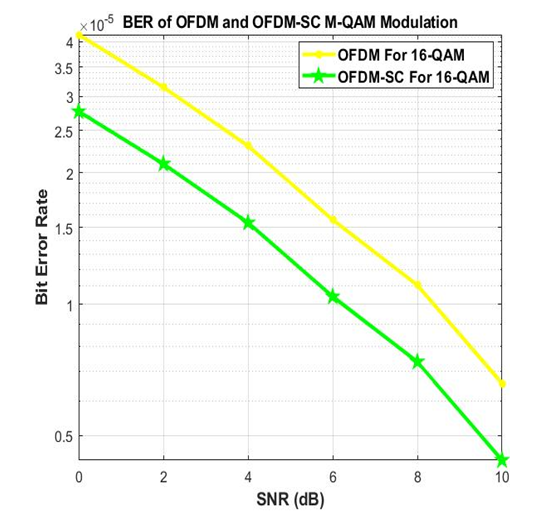 | Figure 2. Bit Error Rate (BER) for OFDM and OFDM-SC at 16-QAM modulation scheme over Rayleigh fading channel |
 | Figure 3. Bit Error Rate (BER) for OFDM and OFDM-SC at 32-QAM modulation scheme over Rayleigh fading channel |
 | Figure 4. Bit Error Rate (BER) for OFDM and OFDM-SC at 64QAM modulation scheme over Rayleigh fading channel |
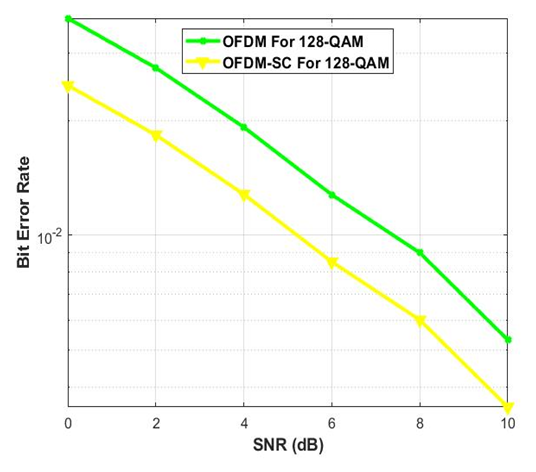 | Figure 5. Bit Error Rate (BER) for OFDM and OFDM-SC at 128QAM modulation scheme over Rayleigh fading channel |
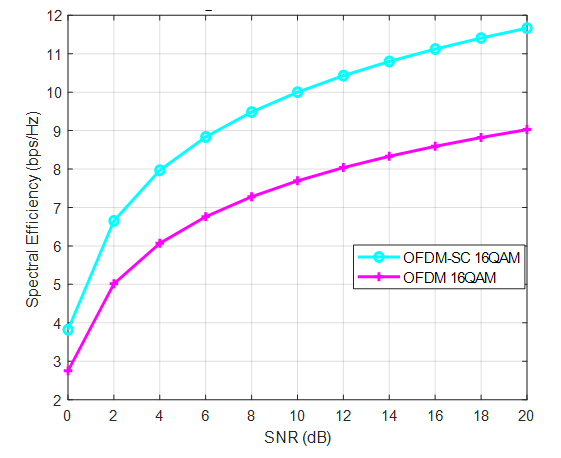 | Figure 6. Spectral Efficiency (SE) for OFDM and OFDM-SC at 16QAM modulation scheme over Rayleigh fading channel |
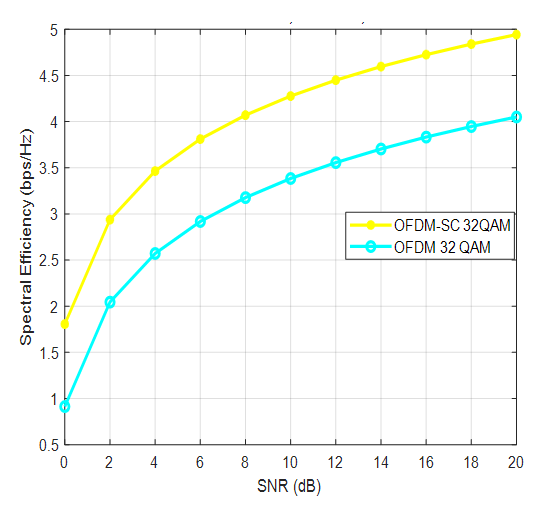 | Figure 7. Spectral Efficiency (SE) for OFDM and OFDM-SC at 16QAM modulation scheme over Rayleigh fading channel |
 | Figure 8. Spectral Efficiency (SE) for OFDM and OFDM-SC at 16QAM modulation scheme over Rayleigh fading channel |
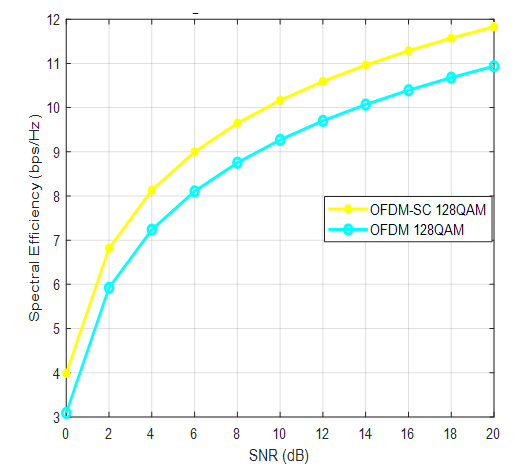 | Figure 9. Spectral Efficiency (SE) for OFDM and OFDM-SC at 128QAM modulation scheme over Rayleigh fading channel |
5. Conclusions
- Comparative analysis of higher constellation is carried out in this paper. The performance of OFDM and OFDM-SC is carried using Bit Error Rate (BER) and Spectral Efficiency (SE) as performance metrics. Mathematical expression of BER and SE are derived using the signal strength of the receive signal. BER is used to measure the error rate while SE is used to measure the bandwidth efficiency of the two techniques at different constellation size. The results obtained revealed that, OFDM-SC has a better performance in term of error reduction with low BER when compared with conventional OFDM. However, there is reduction in bandwidth efficiency of OFDM-SC with low SE values when compared with conventional OFDM. The results obtained also revealed that, at the two techniques, BER values increases as constellation size increases, while, bandwidth efficiency increase with increases in constellation size. The percentage increase in BER between 16QAM and 128QAM is 12%, while the percentage increase in bandwidth efficiency is 68.38%. Therefore, OFDM-SC with higher constellation is recommended to be used since the percentage increase in bandwidth efficiency is far higher than percentage increase in error rate when using higher constellation. Therefore, OFDM-SC with higher constellation has been shown to have better performance with high bandwidth efficiency. It is concluded that, whenever OFDM-SC is to be used in wireless system, a higher constellation size of modulation such 128QAM and 64QAM must be used to modulate the base band signal.
 Abstract
Abstract Reference
Reference Full-Text PDF
Full-Text PDF Full-text HTML
Full-text HTML